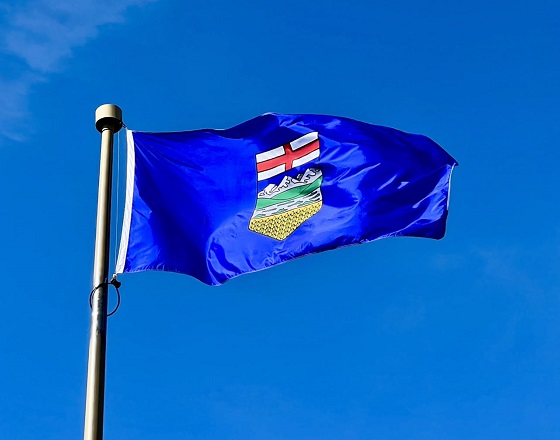Alberta
Alberta government should pay dividends to Albertans from Heritage Fund

From the Fraser Institute
By Tegan Hill and Joel Emes
Despite promising in February to rebuild the Heritage Fund to help eliminate Alberta’s reliance on resource revenue, last month Alberta Premier Danielle Smith said she plans to use income from the fund to “assist in de-risking projects” in the oil and gas sector (in other words, projects that can’t secure financing from private lenders). Clearly, if Alberta has any hope of building up the Heritage Fund, it needs robust fiscal rules to help ensure governments responsibly grow the fund—and don’t raid it for other purposes.
The Lougheed government created Alberta’s Heritage Fund in 1976 to save a share of the province’s resource revenue for the future. Since its creation, however, governments have only contributed resource revenue in 11 out of 48 years of the fund’s existence, and just 3.9 per cent of total resource revenue has been deposited in the fund over its lifetime. Instead, governments have largely spent away onetime resource revenues, contributing to Alberta’s boom-and-bust cycle, rather than saving a share of resource revenue to turn it into a financial asset that can generate steady income over time.
While Premier Smith says she wants to build up the fund so its investment income (i.e. earnings) can eventually replace resource revenue in the budget, the fund’s earnings in 2023/24 are a projected $2.1 billion compared to a projected $19.4 billion in resource revenue. Obviously, Alberta needs a new approach to grow the fund. On this front, it can look to Alaska’s experience with its Permanent Fund, which was also created in 1976 but has grown much larger over time.
Unlike Alberta’s Heritage Fund, Alaska’s fund operates under robust fiscal rules. First, according to Alaska’s constitution, the state government must deposit at least 25 per cent of all mineral revenues into the fund each year. Alberta could introduce a similar constitutional rule.
In addition, a share of the Alaska fund’s earnings are set aside each year to ensure that the principal of the fund is not eroded through inflation. Alaska also prohibits use of the principal without approval by a referendum; the government may only spend the earnings of the fund (minus what’s needed to inflation-proof the principal).
And crucially, there’s the dividends—a topic that would surely pique the interest of many Albertans. In Alaska, the government pays a share of the fund’s earnings to Alaskan citizens via a dividend, which has helped support growth in the fund over the long term. By giving citizens an ownership share in the state’s resource fund, Alaskans recognize their vested interest and demand that the state maximize returns. Put simply, due to the annual dividend, Alaskans want the government to maintain the Permanent Fund’s health. And any government that tried to use the fund for irresponsible purposes would face the ire of Alaskan voters.
Which brings us back to Alberta. If the Smith government began contributing 25 per cent of resource revenue to the Heritage Fund and inflation-proofing the principal this year, it could pay each Albertan a dividend worth between $148 to $297 in 2024/25, equivalent to $594 to $1,187 per family of four. From 2024/25 to 2026/27, each Albertan could receive a total of $571 to $1,108 in dividends, equivalent to $2,284 to $4,430 per family of four. And as the fund grows, so would the dividends.
The Smith government has promised to rebuild the Heritage Fund, yet at the same time wants to use the fund’s earnings to “assist in de-risking” energy projects in the province. Without a mechanism to ensure growth of the fund, it will remain vulnerable to the whims of governments. Alberta should learn from Alaska’s success and start paying annual dividends to Albertans.
Authors:
Alberta
Median workers in Alberta could receive 72% more under Alberta Pension Plan compared to Canada Pension Plan

From the Fraser Institute
By Tegan Hill and Joel Emes
Moving from the CPP to a provincial pension plan would generate savings for Albertans in the form of lower contribution rates (which could be used to increase private retirement savings while receiving the same pension benefits as the CPP under the new provincial pension), finds a new study published today by the Fraser Institute, an independent, non-partisan Canadian public policy think-tank.
“Due to Alberta’s comparatively high rates of employment, higher average incomes, and younger population, Albertans would pay a lower contribution rate through a separate provincial pension plan while receiving the same benefits as under the CPP,” said Tegan Hill, director of Alberta policy at the Fraser Institute and co-author of Illustrating the Potential of an Alberta Pension Plan.
Assuming Albertans invested the savings from moving to a provincial pension plan into a private retirement account, and assuming a contribution rate of 5.85 per cent, workers earning the median income in Alberta ($53,061 in 2025) could accrue a stream of retirement payments totalling $454,741 (pre-tax)—a 71.6 per cent increase from their stream of CPP payments ($264,968).
Put differently, under the CPP, a median worker receives a total of $264,968 in retirement income over their life. If an Alberta worker saved the difference between what they pay now into the CPP and what they would pay into a new provincial plan, the income they would receive in retirement increases. If the contribution rate for the new provincial plan was 5.85 per cent—the lower of the available estimates—the increase in retirement income would total $189,773 (or an increase of 71.6 per cent).
If the contribution rate for a new Alberta pension plan was 8.21 per cent—the higher of the available estimates—a median Alberta worker would still receive an additional $64,672 in retirement income over their life, a marked increase of 24.4 per cent compared to the CPP alone.
Put differently, assuming a contribution rate of 8.21 per cent, Albertan workers earning the median income could accrue a stream of retirement payments totaling $329,640 (pre-tax) under a provincial pension plan—a 24.4 per cent increase from their stream of CPP payments.
“While the full costs and benefits of a provincial pension plan must be considered, its clear that Albertans could benefit from higher retirement payments under a provincial pension plan, compared to the CPP,” Hill said.
Illustrating the Potential of an Alberta Pension Plan
- Due to Alberta’s comparatively high rates of employment, higher average incomes, and younger population, Albertans would pay a lower contribution rate with a separate provincial pension plan, compared with the CPP, while receiving the same benefits as under the CPP.
- Put differently, moving from the CPP to a provincial pension plan would generate savings for Albertans, which could be used to increase private retirement income. This essay assesses the potential savings for Albertans of moving to a provincial pension plan. It also estimates an Albertan’s potential increase in total retirement income, if those savings were invested in a private account.
- Depending on the contribution rate used for an Alberta pension plan (APP), ranging from 5.85 to 8.2 percent, an individual earning the CPP’s yearly maximum pensionable earnings ($71,300 in 2025), would accrue a stream of retirement payments under the total APP (APP plus private retirement savings), yielding a total retirement income of between $429,524 and $584,235. This would be 22.9 to 67.1 percent higher, respectively, than their stream of CPP payments ($349,545).
- An individual earning the median income in Alberta ($53,061 in 2025), would accrue a stream of retirement payments under the total APP (APP plus private retirement savings), yielding a total retirement income of between $329,640 and $454,741, which is between 24.4 percent to 71.6 percent higher, respectively, than their stream of CPP payments ($264,968).

Joel Emes
Alberta
Alberta ban on men in women’s sports doesn’t apply to athletes from other provinces

From LifeSiteNews
Alberta’s Fairness and Safety in Sport Act bans transgender males from women’s sports within the province but cannot regulate out-of-province transgender athletes.
Alberta’s ban on gender-confused males competing in women’s sports will not apply to out-of-province athletes.
In an interview posted July 12 by the Canadian Press, Alberta Tourism and Sport Minister Andrew Boitchenko revealed that Alberta does not have the jurisdiction to regulate out-of-province, gender-confused males from competing against female athletes.
“We don’t have authority to regulate athletes from different jurisdictions,” he said in an interview.
Ministry spokeswoman Vanessa Gomez further explained that while Alberta passed legislation to protect women within their province, outside sporting organizations are bound by federal or international guidelines.
As a result, Albertan female athletes will be spared from competing against men during provincial competition but must face male competitors during inter-provincial events.
In December, Alberta passed the Fairness and Safety in Sport Act to prevent biological men who claim to be women from competing in women’s sports. The legislation will take effect on September 1 and will apply to all school boards, universities, as well as provincial sports organizations.
The move comes after studies have repeatedly revealed what almost everyone already knew was true, namely, that males have a considerable advantage over women in athletics.
Indeed, a recent study published in Sports Medicine found that a year of “transgender” hormone drugs results in “very modest changes” in the inherent strength advantages of men.
Additionally, male athletes competing in women’s sports are known to be violent, especially toward female athletes who oppose their dominance in women’s sports.
Last August, Albertan male powerlifter “Anne” Andres was suspended for six months after a slew of death threats and harassments against his female competitors.
In February, Andres ranted about why men should be able to compete in women’s competitions, calling for “the Ontario lifter” who opposes this, apparently referring to powerlifter April Hutchinson, to “die painfully.”
Interestingly, while Andres was suspended for six months for issuing death threats, Hutchinson was suspended for two years after publicly condemning him for stealing victories from women and then mocking his female competitors on social media. Her suspension was later reduced to a year.
-

 Opinion1 day ago
Opinion1 day agoPreston Manning: Three Wise Men from the East, Again
-

 Addictions1 day ago
Addictions1 day agoWhy B.C.’s new witnessed dosing guidelines are built to fail
-

 COVID-191 day ago
COVID-191 day agoTrump DOJ dismisses charges against doctor who issued fake COVID passports
-

 Uncategorized2 days ago
Uncategorized2 days agoCNN’s Shock Climate Polling Data Reinforces Trump’s Energy Agenda
-

 Business1 day ago
Business1 day agoCarney Liberals quietly award Pfizer, Moderna nearly $400 million for new COVID shot contracts
-

 Business1 day ago
Business1 day agoMark Carney’s Fiscal Fantasy Will Bankrupt Canada
-

 Energy22 hours ago
Energy22 hours agoActivists using the courts in attempt to hijack energy policy
-

 conflict15 hours ago
conflict15 hours agoTrump’s done waiting: 50-day ultimatum for Putin to end Ukraine war









